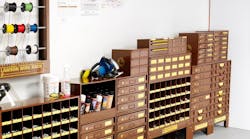Parts inventories can be intimidating to manage, and if not done well, can be costly. Parts are, on average, 50 percent of what labor cost is. Shop and technician productivity is gained in more efficient parts retrieval.
Average technician burdened labor – fixed expenses like federal and state taxes, health insurance, workman’s compensation, uniforms and paid time off – is a dollar per minute. That adds up quickly when a technician is trying to locate a part in a disorganized parts room.
Imagine your significant other giving you the daunting task of sending you to a supermarket to retrieve a specific type and brand of bread. In your growing frustration at locating that particular loaf, you grab one that looks right, but isn’t – the wife scolds you. That necessitates an additional trip to the supermarket.
At times, parts have a tendency to be a power struggle that becomes emotionally fueled. There can be an adrenaline rush to parts buying and a feeling of comfort in “the more parts the better.” There’s also the friendship of salespeople and their compelling sales tactics which includes good seats at major sporting events and generous offerings.
With a lack of parts management and control comes inefficiency due to:
- Not knowing what is in stock.
- An overabundance of parts, and not necessarily needed parts.
- An increase in obsolete parts.
- Not being able to finds inventoried parts.
With all this, parts spending becomes the bullseye of the moment.
There are many items to consider when setting up an efficient parts room. However, the chief objective needs to be: have it neat, clean and well organized. Think upscale supermarkets. They are visually appealing, simple and systematized.
Here are some parts management best practices developed from my experience with setting up and reorganizing more than 100 parts rooms.
ORGANIZATION
1. Floors. Paint floors with high gloss gray for easy cleaning. Concrete generates and attracts dust and stains.
2. Housekeeping. Once the setup is completed, keep the area neat and clean, orderly and structured.
3. Sorting. Set up the parts room sorting by VMRS (Vehicle Maintenance Reporting Standards) codes, starting at the beginning and following the numbers. Brake parts in section 13, PTO parts in section 25, cooling parts in section 42, etc.
In rare cases, there may be the need to segregate different OEM makes – Mack Trucks parts in its own area, Cummins parts in its own area, Carrier Transicold parts in its own area and so forth – but also sort by VMRS codes.
4. Shelf numbering. Use letters for the isles and numbers for sections and shelves. Location B37 would indicate isle B, section 3, shelf 7.
5. Shelf layout. Lay out shelves for easy maneuvering and with adequate space between the isles.
6. Off the floor. No parts should be stored on the floor or in aisles or walkways.
7. Boxes. All parts should be stored in a box, whether cardboard or plastic. Plastic boxes last longer.
8. Angle Bins. These bins are easily accessible and allow quick retrieval of small parts, such as wire terminals, hose clamps, brass and fittings, nuts and bolts, small decals, bulbs, etc.
9. Pigeonhole Bins. These are not recommended for storing and organizing smaller parts and materials because they tend to easily become cluttered.
10. Computers. Place them near the parts access path to ensure posting of all parts as they leave the parts room. If there is a lot of cluttered clipboards and whiteboards in the parts room, you’re probably inefficient.
11. Labeling. Place labels on the box as well as on the part. Labels should be double-back so they can be removed and placed on a paper repair order. This also helps for a tighter control for the posting of parts.
12. Magnetics. Do not stick labels to any shelf. If a part is moved, it is difficult to remove the lapel, and often this never gets done. Labels should be placed on a magnetic strip, which can be easily relocated.
13. Filters. Often, filters are stored in multiple places, if purchased in bulk. Normal shop operations should be a two-week supply, purchased in case lots for ease of handling and invoice processing.
14. Spray lubes. These should be inventoried and not an expendable item. If these parts are charged out, there will be less waste and tighter controls. Plus, they will show up on the reorder report when required, provided minimums and maximums are properly set.
15. Snap ties. An easy way to store snap ties is in PVC pipes or in paint cans placed at the end of parts isles, as this makes for easy retrieval and control. Snap ties should have a generic part number, such as ST.
16. Special order shelf. Have a specific shelf, painted green for “go,” in a specific area for special order parts. Each part should be tagged, have the date for installation and the ID of the vehicle on which it will be placed. If the part is not installed on a vehicle within a short period, say one week, return the part for credit.
17. Warranty shelf. Have a specific shelf, painted red for “stop,” in a specific area for warranty parts. Parts should be tagged and dated for a specific vehicle. Have areas on the shelf numbered 0 to 9. Sort the warranty parts by the last number of the vehicle or repair order.
18. Core shelf. Have a specific shelf, painted yellow for “caution” in a specific area for return core parts. Tag them and note when they are to be returned.
19. Batteries. Store in a specific ventilated area for easy storage and access. Batteries should be marked upon vehicle installation because the warranty starts when installed and not the date coded when manufactured.
20. Consignment. There are many who like consignment parts because they don’t have to be paid for until they are installed on a vehicle. This is not a recommended practice. If you do not own the parts, you will not manage these parts. When the time comes, you could have a large invoice from the lack of posting discipline, and possibly a vendor who “loads” you up on parts.
21. Parts description. These should be clear and concise, not generic. Instead of “brake chamber” use “3-inch long-stroke chamber.”
22. No symbols. Do not use dots, dashes, stars or spaces in part numbers to eliminate confusion during parts entry. It is much easier to remember a part number when there are no symbols.
23. Inventory cycle counts. These should be done at least on a daily or weekly basis. This will replace the massive and time-consuming chore of counting parts quarterly and yearly. Liquids should be counted each month. Rely on the computer for reorder quantities, not parts salespeople.
24 Barcodes. These provide the highest level of inventory control.
With an effective strategy and well-functioning system for parts management, shops can reduce vehicle downtime, increase efficiency, lessen excess inventory and parts handling and decrease capital costs. All of this helps improve the bottom line.
Darry W. Stuart is president and CEO of DWS Fleet Management Services (www.darrystuart.com), an independent “Limited Time Executive” transportation and fleet management business. Established in 1999, he and his team work with companies to lower operating costs and drive change. Stuart has more than 46 years of expertise in fleet management.



